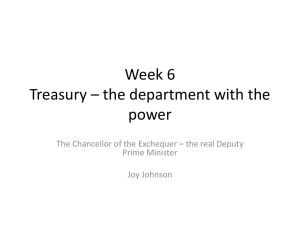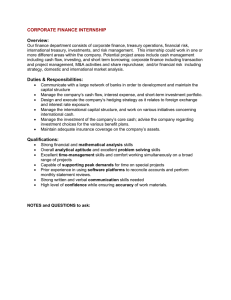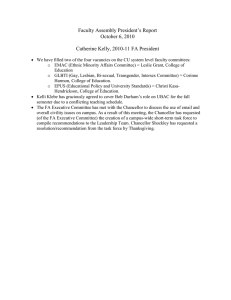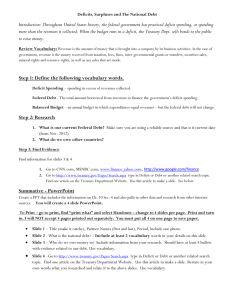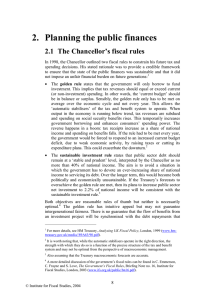1. Summary Planning the public finances
advertisement
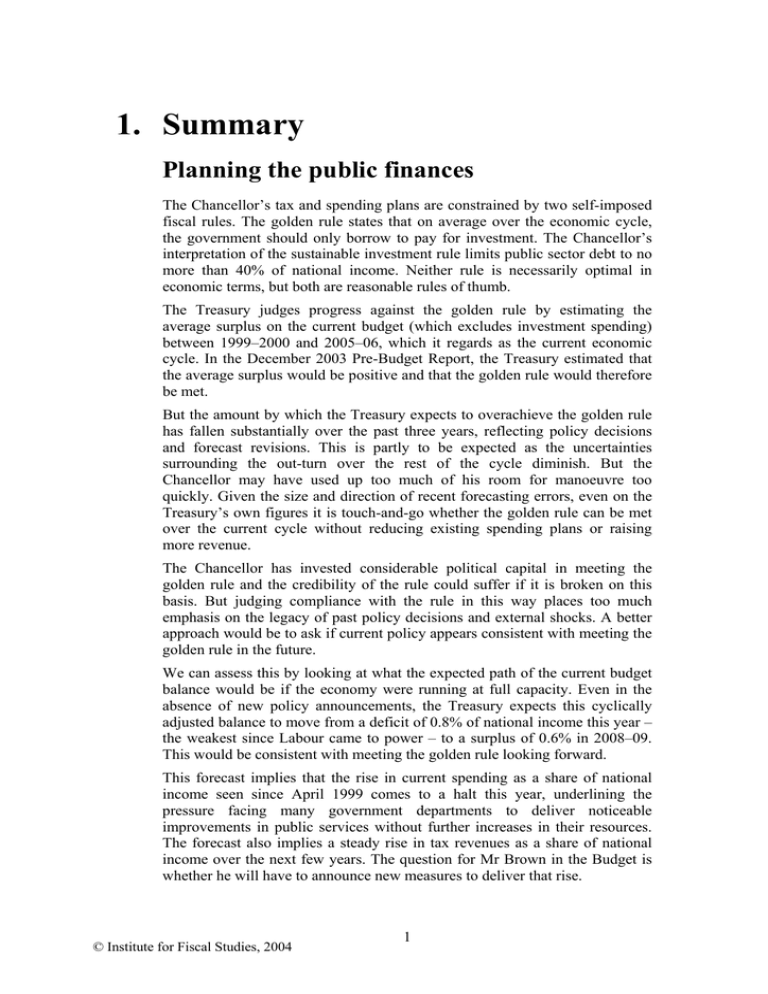
1. Summary Planning the public finances The Chancellor’s tax and spending plans are constrained by two self-imposed fiscal rules. The golden rule states that on average over the economic cycle, the government should only borrow to pay for investment. The Chancellor’s interpretation of the sustainable investment rule limits public sector debt to no more than 40% of national income. Neither rule is necessarily optimal in economic terms, but both are reasonable rules of thumb. The Treasury judges progress against the golden rule by estimating the average surplus on the current budget (which excludes investment spending) between 1999–2000 and 2005–06, which it regards as the current economic cycle. In the December 2003 Pre-Budget Report, the Treasury estimated that the average surplus would be positive and that the golden rule would therefore be met. But the amount by which the Treasury expects to overachieve the golden rule has fallen substantially over the past three years, reflecting policy decisions and forecast revisions. This is partly to be expected as the uncertainties surrounding the out-turn over the rest of the cycle diminish. But the Chancellor may have used up too much of his room for manoeuvre too quickly. Given the size and direction of recent forecasting errors, even on the Treasury’s own figures it is touch-and-go whether the golden rule can be met over the current cycle without reducing existing spending plans or raising more revenue. The Chancellor has invested considerable political capital in meeting the golden rule and the credibility of the rule could suffer if it is broken on this basis. But judging compliance with the rule in this way places too much emphasis on the legacy of past policy decisions and external shocks. A better approach would be to ask if current policy appears consistent with meeting the golden rule in the future. We can assess this by looking at what the expected path of the current budget balance would be if the economy were running at full capacity. Even in the absence of new policy announcements, the Treasury expects this cyclically adjusted balance to move from a deficit of 0.8% of national income this year – the weakest since Labour came to power – to a surplus of 0.6% in 2008–09. This would be consistent with meeting the golden rule looking forward. This forecast implies that the rise in current spending as a share of national income seen since April 1999 comes to a halt this year, underlining the pressure facing many government departments to deliver noticeable improvements in public services without further increases in their resources. The forecast also implies a steady rise in tax revenues as a share of national income over the next few years. The question for Mr Brown in the Budget is whether he will have to announce new measures to deliver that rise. © Institute for Fiscal Studies, 2004 1 Green Budget, January 2004 As long as the golden rule is met, the sustainable investment rule is unlikely to constrain the government’s ability to fulfil its spending plans. If investment undertaken through the Private Finance Initiative were to have been conventionally financed through borrowing, public sector net debt would be likely to exceed the 40% ceiling in the next few years, but the Chancellor might reasonably argue that if the figures were to be calculated in this way, he would have set the target higher. The government may also face other liabilities that do not count as public sector net debt. But with the headline figure at modest levels by both international and historic standards, they would be unlikely to affect any fundamental assessment of the sustainability of the government’s finances. In addition to the two fiscal rules Mr Brown has set himself, he has also in principle been committed to the rules implied by the Maastricht Treaty. The Treasury predicts that it will be in breach of the 3% of national income budget deficit limit this year, but argues that this should be interpreted with reference to the cyclically adjusted figure, which remains below 3%. In any event, the decision not to censure France and Germany for breaking the limit means that the Stability and Growth Pact has in effect been suspended. The Treasury has argued that fiscal policy could be used more actively to help stabilise the economy in the event that the UK adopts the Euro and therefore loses the ability to set monetary policy to suit domestic conditions. In order to allay fears that the government would be keener to loosen policy in bad times than to tighten it in good times, it has canvassed opinion on the possibility of creating an extra fiscal rule that would mandate an explicitly temporary tax change in the event that economic activity strongly diverged from its longterm sustainable level. It is not clear how such a rule would affect people’s spending behaviour and therefore whether it would have a reliably stabilising impact on the economy. IFS public finance forecasts The Green Budget is marginally more optimistic than the Pre-Budget Report about the public finances during the current financial year, expecting a current budget deficit £600 million lower than the Treasury, at £18.7 billion, and public sector net borrowing £700 million lower than the Treasury, at £36.7 billion. This reflects our slightly higher forecasts for social security and corporation tax receipts, plus an assumption that the government does not need to spend the £300 million remaining in the contingency reserve within annually managed expenditure (AME). For 2004–05, we are slightly more pessimistic than the Treasury, expecting a current deficit of £12.0 billion (compared with £8.3 billion in the Pre-Budget Report) and public sector net borrowing of £34.7 billion (compared with £31.0 billion in the Pre-Budget Report). This reflects a more pessimistic forecast for revenues from income tax, corporation tax, fuel duties and council tax (partially offset by a more optimistic view on VAT and social security contributions), combined with an assumption that the Treasury needs £1 billion to rebuild the AME margin. 2 Summary We are also more pessimistic than the Pre-Budget Report about the mediumterm prospects for the public finances, because we expect revenues to be lower and spending higher than the Treasury projects. By 2007–08, we expect current receipts to be 0.6% of national income lower than the Treasury. This reflects our belief that it is prudent not to expect corporation tax revenues to exceed the average of recent years and that the Treasury may be overoptimistic about the revenue it will derive in aggregate from ‘other taxes’, which include stamp duties, capital gains tax, inheritance tax, council tax and business rates. For spending, we adopt the assumptions in the Pre-Budget Report, which are slightly less generous in real terms than those in last year’s Budget, but adjust them for the need to rebuild the AME margin and for the increase in debt servicing costs that results from our higher borrowing path. The overall impact is that we expect public sector net borrowing to be £38 billion in 2006–07 and 2007–08 rather than the £27 billion predicted in the Pre-Budget Report. And while the Treasury expects the current budget to be in balance in 2006–07 and in surplus by £4 billion in 2007–08, we expect a deficit of £11 billion narrowing to a deficit of £7 billion. Our forecasts imply an average current budget surplus of 0.0% of national income a year over the current economic cycle, just meeting the golden rule, but with less margin for error than shown by the Pre-Budget Report. However, summing the cash values of the budget balances over the cycle – the method of calculation favoured by the Chancellor in his 2003 Budget and 2002 Pre-Budget Report speeches – we predict a cumulative deficit of £6½ billion rather than the cumulative surplus of £4½ billion forecast in the last Pre-Budget Report. On that basis, the golden rule would be missed. Our forecasts do not imply that there is a crisis in the public finances. The government’s debt remains modest by international and historical standards. But the Chancellor has said that he wishes to be judged by the fiscal rules he set himself in 1998. Against that benchmark, in the absence of fresh policy measures, we do not believe that he can expect to meet the golden rule on a forward-looking basis with the comfort he has sought in previous Budgets. We assume from past experience that if the Chancellor comes to share this view, he will opt to announce fresh tax increases rather than cut his spending plans. Our forecasts suggest that the next economic cycle will begin in 2006–07 with a current budget deficit of 0.8% of national income. To safeguard the golden rule in the future would require this gap to be closed. This would require the announcement of fresh tax increases worth around £10 billion. But in the last Budget, Mr Brown aimed for a cyclically adjusted current budget surplus of 0.6% of national income at the end of his forecasting period. This was justified in part on the grounds that the public finances might be less healthy than they seem if the Treasury has overestimated the amount of spare capacity in the economy. This seems a pertinent concern now, given that the IMF, OECD and Bank of England all appear to believe that the Treasury is overestimating the amount of spare capacity. To achieve a cyclically adjusted surplus of 0.6% of national income in the first year of the next cycle would require new tax measures raising £17 billion. But Mr Brown indicated in the last Budget that he was happy with a surplus of 3 Green Budget, January 2004 0.4% of national income in 2006–07, relying on fiscal drag to raise taxes by the extra 0.2% of national income in the following year. This implies that Mr Brown needs to announce extra tax increases worth £13 billion to expect to meet the golden rule looking forward with the comfort he sought in last year’s Budget. There is no indication that the Chancellor shares this belief. But if he comes to do so, he should act promptly to maintain the credibility of his fiscal framework. Options for raising revenue Income tax, National Insurance (NI), VAT and excise duties are currently the government’s largest sources of revenue. If the Chancellor decides that he needs to raise more money, they offer potential tax-raising opportunities. The simplest way to raise money would be to increase income tax or NI rates. The government has pledged not to increase the basic or higher rates of income tax during this Parliament, so higher NI rates look the more likely of the two. The last increase in NI rates took effect in April 2003 and meant employees and the self-employed paid contributions (at a rate of 1%) for the first time on earnings above the upper earnings limit. Increasing this contribution rate from 1% to 6% would raise a little over £4 billion, with the burden falling overwhelmingly on the richest tenth of the population. Raising the upper earnings limit for NI to the point at which higher-rate income tax begins to be paid would raise a little over £1 billion. Income tax and NI thresholds rise in line with inflation unless the Chancellor explicitly decides otherwise. This increases revenue as a share of national income because earnings typically rise more quickly than prices. Our estimates suggest that price indexation would increase the number of higherrate income tax payers by 900,000 between 2004–05 and 2009–10, but if thresholds and allowances were frozen, the rise would be 2.4 million. Freezing both income tax and NI thresholds and taking into account the impact on income-related benefits would raise an extra £8.8 billion a year in today’s money by 2009–10. The UK currently charges the full 17.5% rate of VAT on a relatively narrow range of goods and services compared with other countries. Exemption, zerorating and reduced-rating are usually justified by the argument that the relevant items are mainly necessities and so imposing VAT at the full rate would cost lower-income families a larger proportion of income than higherincome families. It would be possible to end these tax breaks and still raise revenue while compensating poorer households. However, the government promised in its last manifesto to maintain almost half of them. Higher excise duties were a big source of revenue in Labour’s first term, but there have been no real increases in duty rates since the last election. At least in the short term, it might be difficult to reduce borrowing by raising fuel duties, as the government has promised that any additional revenues would be spent on transport. A number of other duties are near their revenuemaximising levels or would be likely to involve large political costs in order to raise relatively small amounts of money. With regards to environmental tax, 4 Summary the government has already indicated that a big increase in air passenger duty is unlikely, while initiatives like Ireland’s plastic bag tax are unlikely to raise much revenue. In any case, the government should consult before implementing any significant new environmental taxes. If the Chancellor does want to raise extra money from these taxes, freezing the income tax personal allowance and National Insurance earnings threshold, raising the employees’ National Insurance rate above the upper earnings limit, or moving the upper earnings limit closer to the point at which higher-rate income tax begins to be paid may be the least unattractive options. The taxation of housing The Treasury has been investigating whether tax instruments could be used to help stabilise the housing market and therefore the economy more generally, especially if Britain were to adopt the Euro. In that context, a study published by the Treasury last year argued that ‘investment in housing is relatively lightly taxed compared to other investments’. This suggests that the Chancellor might consider raising housing taxes if he decides in the future that he needs more revenue or to create more stability in the housing market. There are five main taxes levied on housing and housing transactions in the UK: council tax, stamp duty, capital gains tax, inheritance tax and VAT on repairs. The proportion of government revenue raised through housing taxes is larger in the UK than in most other industrial countries. But this does not necessarily imply that housing taxation is too high in the UK. Investment in principal residences does not appear particularly favourably taxed compared with other investments, such as private pensions or ISAs. Second homes are taxed more heavily because of capital gains tax, but the government is considering allowing people to hold residential property in their pension schemes, which would make investing in second homes more attractive. Houses are consumption goods as well as investment goods, and the argument that they are lightly taxed by this yardstick has greater force. However, while housing is the only major durable good zero-rated for VAT, it is liable for both council tax and stamp duty. The government has a number of options if it wants to tax housing more heavily. Putting VAT on new homes is estimated by the Treasury to raise £4.5 billion, but by deterring new housebuilding it would appear contrary to the government’s goal of increasing the supply of houses. The Chancellor has increased stamp duty on house purchases four times already since 1997 and might be concerned that to do so again would further discourage desirable labour mobility. A property wealth tax like that in Denmark might be more effective in stabilising the housing market than stamp duty, but would require more frequent property revaluations than council tax. Extending capital gains tax to principal residences could raise a substantial £11.5 billion, although this would be reduced if the Chancellor felt the need to raise thresholds or exempt gains that are reinvested in housing. In addition, extending capital gains tax would have an adverse impact on labour mobility, particularly if there were exemptions on properties owned for a lengthy period. 5 Green Budget, January 2004 Company taxation Issues raised for consultation In August 2003, the government published a corporation tax reform consultation document for the third summer in a row. Continual consultation does not provide a stable environment for business planning, but the corporate tax system is facing international pressures beyond the government’s control. First, the UK is competing with other countries to make itself an attractive location for businesses. Second, multinational companies are becoming more willing to take national governments to the European Court of Justice if they believe that tax regimes discriminate against them. A potential threat from the European court appears to have motivated Treasury proposals to change the tax treatment of finance leases, which allow UK companies without taxable profits to benefit from capital allowances by leasing assets from companies with taxable profits. Removing the scope for them to do so, as the Treasury suggests, would cease to discriminate against foreign firms. But it would also raise the cost of capital for tax-exhausted domestic companies, which are often new start-ups or small and medium-sized firms. The government is also proposing to apply the OECD’s transfer-pricing guidelines to domestic as well as international transactions. These guidelines prevent multinational firms from shifting profits to low-tax countries by charging prices for transactions within the group that are out of line with market prices. There is no similar incentive to manipulate transfer prices in domestic transactions, but the current rules could be seen as discriminatory. Applying them uniformly will increase compliance costs for companies and the Inland Revenue. Incorporation The 2002 Budget announced a new 0% corporation tax rate for companies with taxable profits below £10,000. The Treasury predicted that this would cost £265 million in 2003–04, but IFS, among others, predicted that the costs would become much greater. The new rate increased the incentive for many self-employed people to form companies in which they are the sole employee and shareholder and thereby reduce their tax bill. For example, a selfemployed person with pre-tax profits of £15,000 pays just under 20% of her income in tax and National Insurance compared with less than 1% if she incorporates and pays herself a salary equal to the personal allowance and the rest as a dividend. The number of incorporations has jumped sharply in the wake of the 0% rate’s introduction. The Chancellor now appears to be considering steps to reduce the differential tax treatment between the self-employed and incorporated businesses, possibly by increasing dividend taxation. A simpler solution, if there is a concern over tax avoidance, would be to remove the 0% corporation tax rate. However, frequent changes to the tax system, particularly if made without prior consultation, do not lead to a stable environment for businesses making longterm investment decisions. 6 Summary Issues in public service delivery The main public services have enjoyed large real increases in spending since April 1999. The NHS is set to continue receiving large increases until March 2008 at least, as is education until March 2006. The current settlements for transport and the police are less generous over the next two years than in the past. There have been noticeable improvements in some outputs. But in areas such as health, education and transport, there is more to do if the government’s targets are to be met. Progress on service delivery has been modest and mixed from area to area. Opinion polls show that most people believe public services have deteriorated since Labour came to power in 1997 and that many are also pessimistic about the future, especially with regard to public transport and the NHS. People are also pessimistic about law and order, but expectations for education are more finely balanced. The government has made wide use of performance targets to promote better service delivery in the public sector. The number of targets has fallen significantly since 1998 and the focus has shifted from inputs and processes to outputs and outcomes. Judging the effectiveness of these targets has been complicated by the government’s tendency to replace them before enough time has elapsed to see whether they have been met. Some critics argue that the extra resources poured in by the government have been wasted in higher costs and wage inflation. Official figures show inflation in general government spending running at about 8% a year – well above the rate in the rest of the economy. But this may reflect improvements in the quality of public services that are not being captured in output estimates. Public sector pay is also rising more quickly than pay in the private sector. But the tentative plans pencilled in for the next spending review should allow public sector wages and employment to rise in line with recent trends and spending on non-wage items still to rise as a share of national income between now and March 2008. It is too early to judge whether recent rises in public sector wages and employment have helped or hindered public sector efficiency. The Pre-Budget Report assumes that public spending rises by 3% a year in real terms in the forthcoming spending review period, from 2005–06 to 2007– 08, rising slightly as a share of national income. Increasing spending at the planned average annual rate for 1999–2005 would cost an extra £4.6 billion a year, while holding spending static as a share of national income would save £2.5 billion a year and freezing it in real terms would save £14.2 billion a year, relative to current plans. 7
